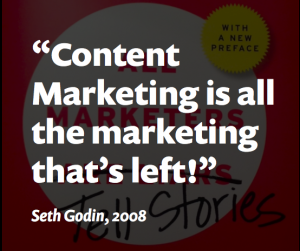
by Delwar Hossain
The primary course of conversation in the past few years for CMO’s and their marketing teams has centered around customer centricity, customer experience, and content marketing. For good reasons too. Customer behaviors have significantly shifted in the last decade impacting conventional thinking on the role of marketing and sales and their abilities to connect with customers.
We have also seen organizations struggle with how best to adapt to new market dynamics related to customer behaviors and the role of content in reaching customers.
What CMO’s need to be on guard for is falling prey to a myopic view of customers without assessing how markets are changing. Specifically, how market behaviors are changing and how these changes impact not only customer behaviors but also market strategies. Missing out on important correlations that can illuminate both important customer and market dynamics. For instance, the rise of platforms such as Amazon and LinkedIn has significantly shifted the way customers interact with products and services. Redefining market rules and design, as well as, impacting customer behaviors.
Convergence of Behaviors
As the digital economy continues to evolve globally, we are seeing an unprecedented convergence of market-oriented behaviors associated with the usages and purchases of products or services. Which, in the past, tended to be viewed separately with clearly defined lines of demarcations. Digital transformation is impacting several areas of market behaviors that are no longer separated by clean lines. Making it harder for businesses to assess markets and get a read on market environments. These four behavioral areas are being impacted, as well as, converging:
(Market) Organizational Behaviors: How people work and interact in work environments today is significantly changing. Traditional corporate hierarchies are slimming down and being replaced by networks of people that are more virtual than ever. New digital technologies are transforming the very concept of how organizations communicate and create new business and operational models in the digital economy.
Buying Behaviors: How people make choices and arrive at purchase decisions are undergoing major transformations. With information readily available, buying behaviors have become more self-directed, as well as, more goal-directed. The reliance on organizational (i.e. vendor) information is diminishing while credibility in influencer sources is rising. Additionally, the concept of clearly separated groups of buyers and users is being replaced by a new concept of networked groups who are simultaneously buyers and users making goal-directed decisions.
Usage Behaviors: How products and services are used today are integrated into all aspects of work and life blurring the lines between how organizations define users and buyers. Whereby the notions of clearly defining decision-makers, approvers, influencers, and users have become an extremely difficult proposition as these notions have converged. Affecting how individuals make choices and decisions with organizations, as well as, personal consumer choices. And, introducing elements of emotions and experience tied to active usage.
(Digital) Interactive Behaviors: How people interact with companies, organizations, and with each other is undergoing a digital revolution. Resulting in new behaviors associated with social interaction, consumer loyalty, information gathering, business relationships, working relationships, and enabling networked-decision behaviors. The spotlight on the decision journey is driven by the tumultuous impact of digital transformation. Altering conventional understanding of decision-making in the most prevalent way. Far more so than in any time in the last 50 years. New technologies such as mobile, cloud, social platforms, data analytics, and artificial intelligence are reshaping consumer and business behaviors significantly. And, reshaping how consumers and businesses make everyday choices, as well as, high-stake decisions.
Reframing Market Strategy
The convergence of market-oriented behaviors and new market rules are asking senior executives to reframe their overall market strategies. Knowing full well that reframing market strategies are tied to answering the questions of where the next area of growth will come from and what path they need to take to achieve growth.
For instance, for the past 2 to 3 years Genesys has been adapting to new market rules and new market-oriented behaviors affecting contact center and customer service management. Affecting the development of market strategy is a multitude of market forces. Primarily driven by digital transformation. Movement from hosted environments to the cloud, the SMB market enabled by digital technologies to be on equal footing with large enterprises in their customer service capabilities, increase in mobile technology as a key touchpoint, an increase in executive decision-makers who want hands-on and daily interaction with critical applications – in essence becoming important users, and addressing omnichannel engagement.
These just name a few. Genesys embarked on qualitative user and buyer research to understand how such market-oriented behaviors were shifting, as well as, converging. Putting them on a renewed market strategy path that targeted new segments and introduced new product and service innovations. By understanding how organizational behaviors, buying behaviors, usage behaviors, and digital interactive behaviors were evolving in a digital economy, they were in a better position to map out market strategies that allowed for new areas of growth and more extensive market penetration in existing markets.
On a much larger scale, the recent announcement by AT&T to acquire Time Warner is very much about reinventing market strategy due to tectonic shifts in behaviors. Doing so to adapt to new consumer behaviors related to how media content is consumed and viewed. Largely driven by digital technology advancements in smartphones, tablets, and streaming. Leading to more consumers getting their entertainment media from Netflix and watching on iPhones or iPads instead of TVs.
Evolving Market Strategy By Understanding Behaviors
Digital transformation is now asking executives to have a keener sense of mapping out market strategies that result in growth. Gaining this keener sense requires understanding how market-oriented behaviors are transforming. Such understanding leads to identifying new market segments, new pricing strategies, new product innovation roadmaps, and improved customer engagements.
How executives acquire such insights today means conventional thinking on researching buyers and users separately needs a reboot. For example, persona-based research can no longer be relegated to just buyer personas or user personas in a digital economy. Working with several organizations in the past two years, I have seen this convergence of behaviors blur the lines between a previous common separation between buyer and user personas. (More on this in the near future.)
Not adapting soon enough carries significant risks. When business entities, whether they serve consumers or businesses, are no longer able to align with the behaviors of their markets and customers, they run the risk of being left behind. One way to not be left behind is to rethink market strategies today in light of an evolving digital economy.
(The following video features Richard Heaslip from Google in a TED presentation on how digital technologies are changing the way we do business and the business environment in an evolving digital economy.)
Business & Finance Articles on Business 2 Community
(69)








